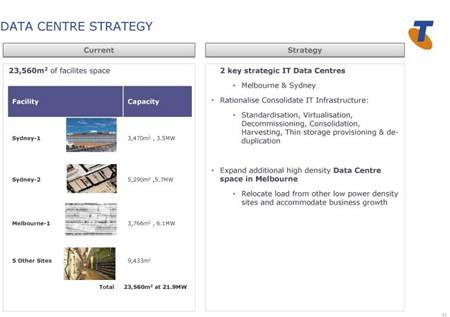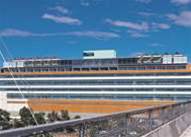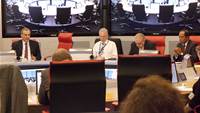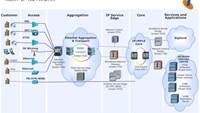EXCLUSIVE: Telstra is considering pulling a large fleet of servers housed within Sydney's giant Global Switch data centre as it consolidates its data centre footprint.
Telstra told journalists at a Technology Briefing today that it aims to consolidate its three current datacentres (as well as IT systems placed in a half dozen smaller facilities) down to two centralised datacentres - one in the Sydney business district of St Leonards and another in Clayton, Melbourne, currently under construction.
"The major, big data centres - the two data centres [with a] complete virtualised environment [for] cloud offerings, will be in Clayton and St Leonards, here in Sydney," said Telstra chief operations officer, Michael Rocca [see video below], to the agreement of two of his colleagues.
According to a slide shown at the briefing, Telstra currently has data centre space at two major Sydney facilities. Some 3,470 square metres of data centre space is listed at its 'Sydney-1' data centre, which from the accompanying photography is undoubtedly Global Switch.
 |
| Telstra reveals its data consolidation plans (click to enlage) |
iTnews subsequently asked whether Telstra plans to exit the 3,470 square metres of space it leases at Global Switch, which operates at around 3.5 kW per rack, under the consolidation plan.
A Telstra spokesman later said that despite the company's COO, interim CIO and head of network and technology all clearly stating that "St Leonards" would be the site of the Sydney data centre under the consolidation plan [see video below], Telstra was actually "undecided" as to which Sydney facility it would decommission.
Global Switch has been contacted for comment.
The Clayton, Melbourne facility that is likely to replace Telstra's racks at Global Switch is still under construction. It features 1200 square metres of server room space today, with a further 2000 square metres of high density compute space planned for future growth.
The Clayton facility will also feature free cooling (using ambient outside air to computing equipment whenever it is below the temperature of air inside the data centre) and trigen power (using a gas turbine to generate power on-site, fed back into the local grid and used as a failover source of power if the local grid goes down).
Silver Lining data centres
Initially the two data centres will be used for Telstra's internal systems, but over time they will form the central hub of server and storage power for Telstra's 'Silver Lining' cloud computing service.
The vendor revealed today that its 'Silver Lining' cloud compute service uses Cisco UCS servers running the VMware vSphere operating system, Cisco Nexus switches (providing fibre channel and IP connectivity) and storage arrays from both EMC and NetApp.
Silver Lining will also use network monitoring software supplied by HP and automation, configuration management and service management software from BMC.
Lavaro said that customers of 'Silver Lining' - the first of which are already coming online, will be spared having to invest in such infrastructure and consume this compute and storage as a service.
"They can buy it on a pay as you go basis," he said.
Read on for Page 2 - Telstra's virtualisation update and 12 media content centres...
Virtualisation project
Telstra CIO Ashley Lavaro said the telco is virtualising both its x86 and SPARC server systems and is consolidating in excess of 100 data storage arrays down to "a handful."
The company has decommissioned over 1000 physical x86 servers to date and is achieving a virtual server to physical server ratio in the order of 25:1.
Storage-wise, the consolidated data centres will run with a mix of solid state storage (for fast access) and low-cost SATA (serial ATA) disk. The telco has also invested in thin provisioning and de-duplication smarts to reduce its total data storage load.
A dozen distributed network data centres
As reported earlier on iTnews today, the telco also announced plans to spend $14 million building out twelve "network media centres" -- small data centres housed within telephone exchanges -- across Australia's major cities over the next three to five years.
These network media centres will be located at existing Ethernet aggregation points that Telstra has built for its Next IP network. There are a further 147 such aggregation points, should the telco see stronger than expected demand for its media content distribution.
The first of these network media centres has been kitted out in the Sydney CBD enclave of Haymarket [see photo gallery attached], with another under construction in Lonsdale, Melbourne.
The Haymarket prototype features up to 24 server and storage racks and two racks of network kit, capable of running at between 15kW to 30kW per rack, housed within a 35 square metre room kitted out with hot aisle containment and overhead cooling. The modular, pod-based design means that network equipment and servers/storage can be wheeled in and out with relative ease.
Telstra will house firewalls, database servers, app servers, web servers and storage within these racks.
Michael Lawrey, executive director of network and technology at Telstra Operations said the network media centres will provide considerable cost savings in terms of power consumption. The 330 kW of equipment load in each room would usually require an additional 270 kW of power to cool in traditional facilities, but in the pod-based housing will only require 59 kW.
Lawrey also revealed Telstra plans to save "a million litres of fresh water a year" in each centre through advanced chilled water cooling techniques.
These small distributed data centres can be used for content services alongside the CDN, but also to regionalise cloud compute services being offered from Telstra's two largest data centres.
"We could, for example, distribute our cloud services from these network media centres should a State Government have a requirement to have their data served from within their borders," Lawrey said.









_(20).jpg&h=140&w=231&c=1&s=0)
_(22).jpg&h=140&w=231&c=1&s=0)



_(26).jpg&w=100&c=1&s=0)

 iTnews Executive Retreat - Security Leaders Edition
iTnews Executive Retreat - Security Leaders Edition











_(1).jpg&h=140&w=231&c=1&s=0)



